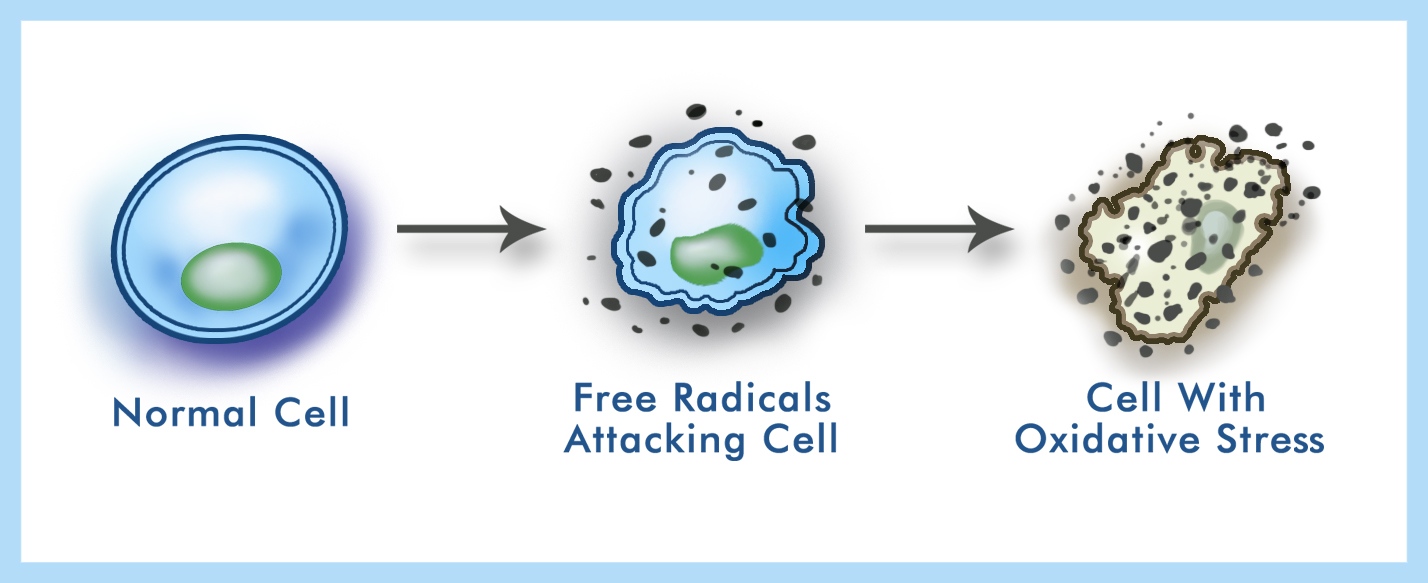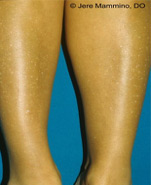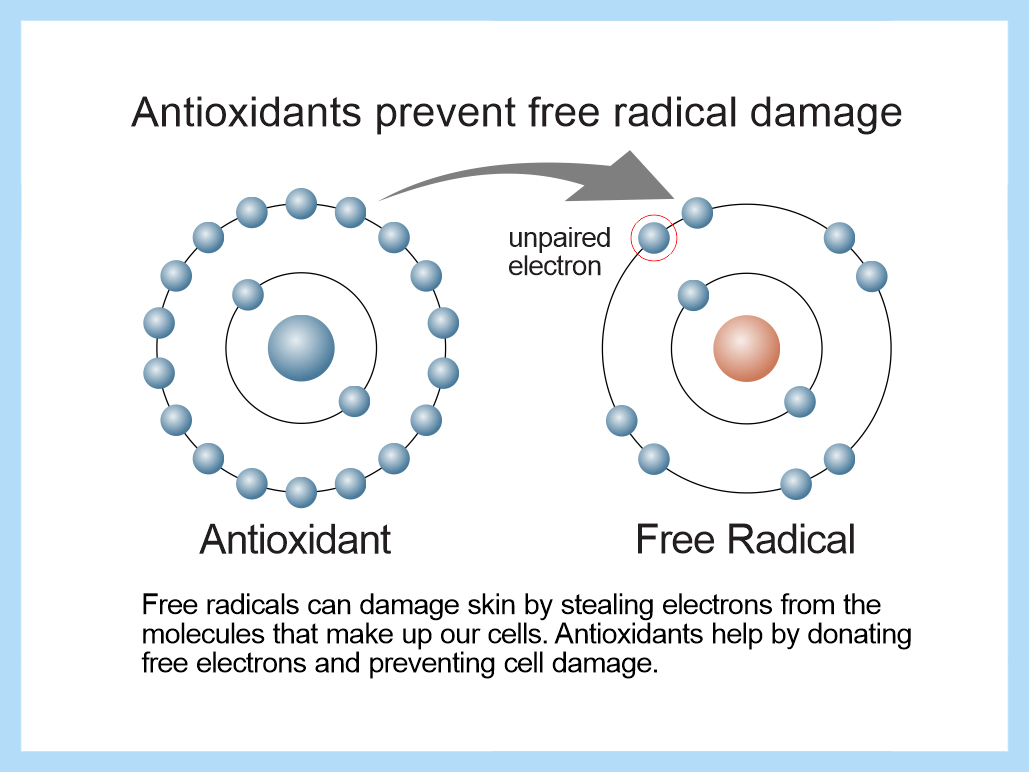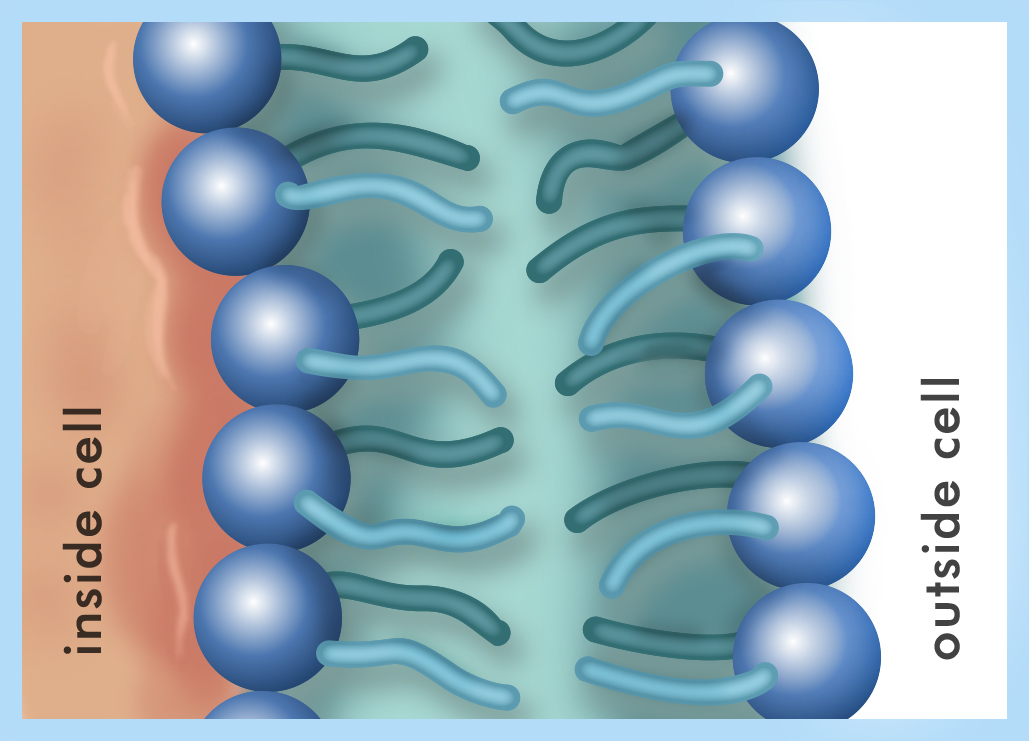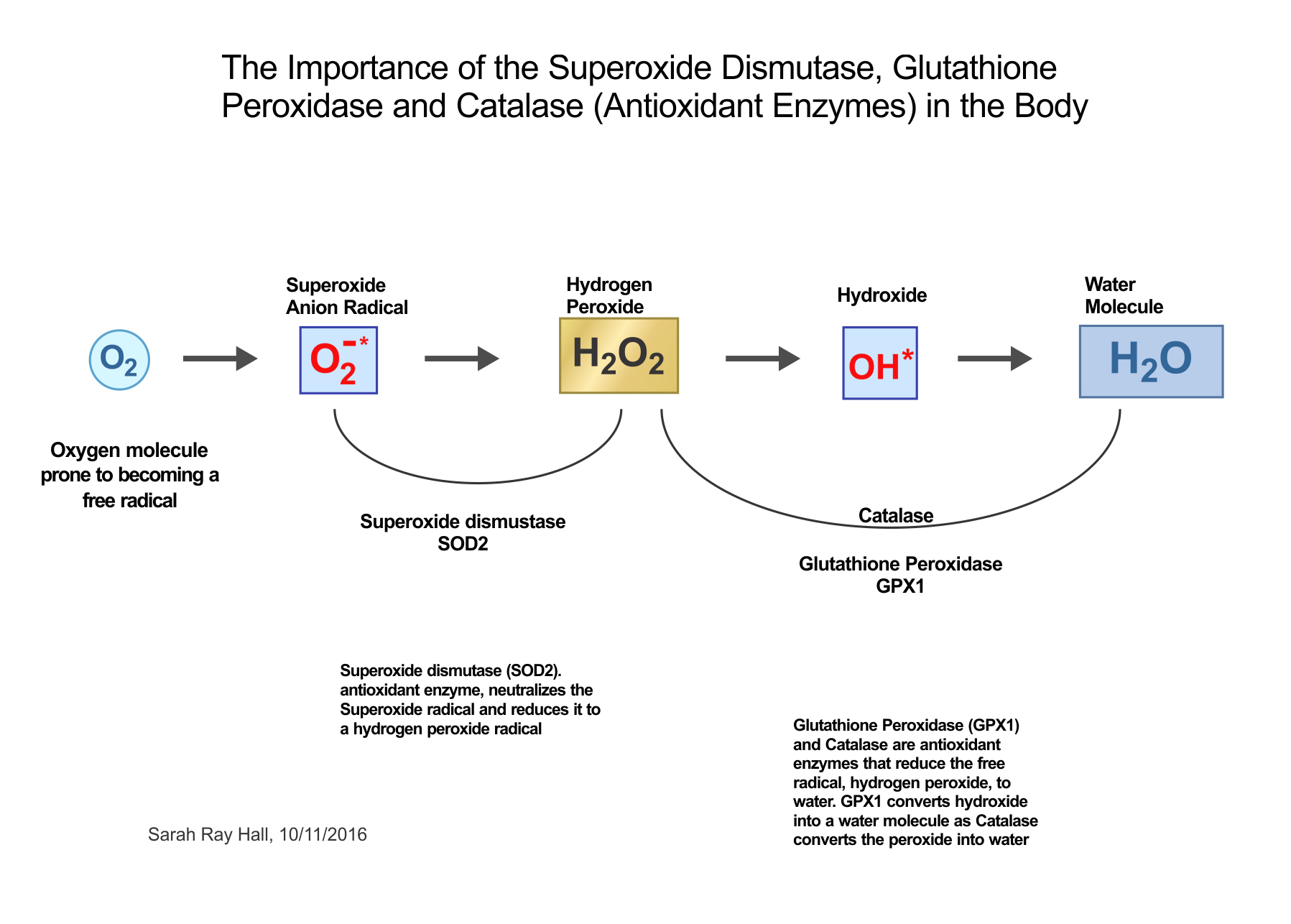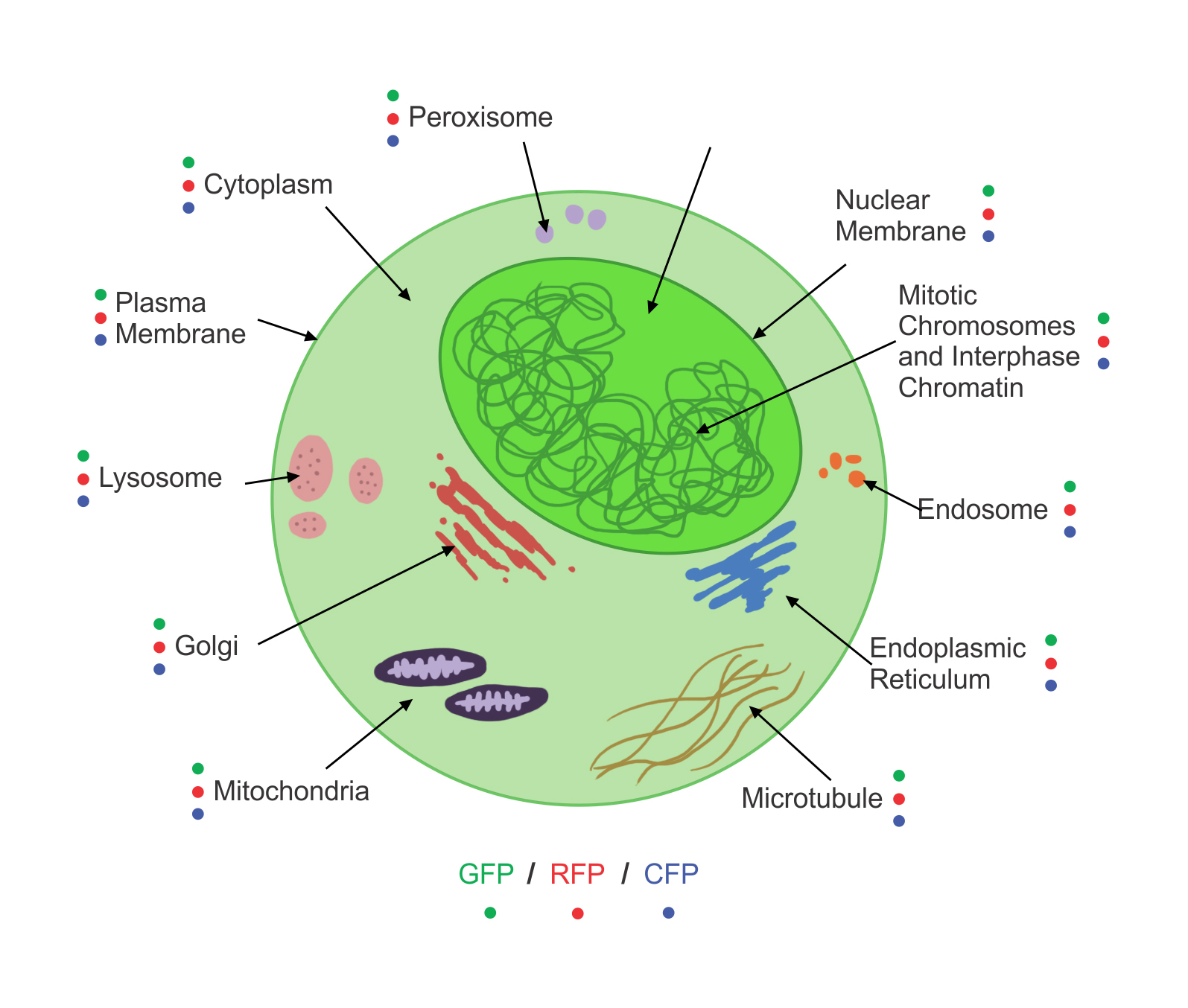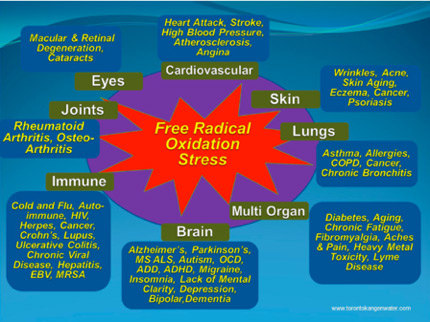This reduced free radical molecule can cross bi-layer lipid membranes easily, meaning it can interact with a transition metal such as ferritin causing the Fenton reaction, which will induce the most dangerous hydroxyl radicals. Another way hydrogen peroxide can turn into the more dangerous free radical hydroxyl is by UV radiation.
The body as your first defense against free radicals
There are pathways regulating the production of important molecules that impart antioxidant activity, such as glutathione peroxidase (GPX1) and superoxide dismutase (SOD). These also regulate the production of detoxification enzymes, including glutathione S-transferase, and down regulate inflammatory signaling factors such as nuclear factor kappa B (NF-ϰB).
Problems arise when you have issues defending your cells from ROS and producing the enzymes that neutralize these free radicals such as ROS, RCS, and RNS. Some may not create enough of the antioxidants needed for the body so you would want to take supplements or use skin care that would increase enzyme activity. Since free radicals are created by so many sources that could negatively affect every category of aging, it is so important to control your exposure to these sources of free radicals because 40% of aging comes from external/exogenous non-genetic factors.
Types of enzymatic antioxidants
Antioxidant enzymes in your body
The most powerful antioxidants are created in your body. They are superoxide dismutase and glutathione peroxidase and they are very important for detoxifying dangerous environmental (exogenous) and internal (endogenous) molecules. When you have genetic variances that cause your body to produce less of one of these antioxidants, you will have accumulation of free radicals that cause oxidative stress to all cells in the body, especially to the skin, resulting in skin aging. For example, a SNP (genetic coding variance) in SOD 2, superoxide dismutase.
You have to protect cells from ROS because it damages their components: proteins, lipids and DNA. The absence of SOD2 causes nuclear DNA damage as well as mitochondrial DNA damage. Nuclear DNA damage promotes further senescence. SOD2, the first line of defense, is found in mitochondrial DNA. It’s also called Mn SOD (manganese superoxide). This antioxidant is important for neutralizing ROS known as superoxides in the mitochondria. It helps to prevent oxidative damage to your mitochondrial DNA. Every day, hour, minute and second, the mitochondria are producing free radicals during a normal cellular process of creating ATP (energy) in the cells.
For example, superoxide anions are created during mitochondrial cellular metabolism. There are cellular enzymatic antioxidants such as SOD2 in the body that help to scavenge these free radicals. When the body is producing more free radicals than the body can neutralize, it can cause cellular damage or senescence. Excess radicals come from sources such as UV and environmental toxins, etc. If you have a defect that causes inefficient use of the enzymes required to quench these free radicals, the same thing can happen. There was evidence that mice without efficient expression of SOD2 enzyme resulted in “significant epidermal thinning.” In humans “mitochondrial dysfunction” promotes “cellular senescence in epidermal keratinocytes in culture.” [7]
This means because of senescence, there were fewer cells in the epidermis, causing it to be thinner. It also affected proliferation and differentiation in keratinocytes. SOD2 deficiency increased differentiation in keratinoctes and caused excessive corneocytes (stratum corneum cells) production in stratum corneum. Yet, there is a decrease in proliferation because of the senescence resulting in decreased epidermal thickness. “SOD2 deficiency resulted in mitochondrial dysfunction and cellular senescence in the epidermis, as well as epidermal thinning, a known feature of aging skin.” [8]
What this means is you get an increased thickness of the stratum corneum and thinning in the epidermis.
Because the skin is the protective barrier to the environment, it can receive direct oxidative damage in the epidermis. In a mouse model, the effects are seen much sooner in epidermis than the effects seen in the connective tissue with “accelerated aging phenotypes (e.g., weight loss, skin atrophy, kyphosis, osteoporosis, muscle degeneration.” [7]
When ROS levels are too high, it will cause senescence as previously mentioned and also a feedback loop that will cause more senescence. It is the damage that accumulates in DNA from ROS that signals this senescence state of cells. DNA double strand breaks can be caused by a gene defect in the SOD2 pathway. (Please see Sun Damage and Pigmentation category.)
Also, “Superoxide radicals are produced by skin cells that are infected with Propionibacterium acnes, the bacterium that causes acne.” [9]
B3-nicotinamide, a derivative of niacin, is required by the body for the production of certain coenzymes essential for proper functioning of superoxide dismutase. [10]
GPX1
Glutathione peroxidase reduces hydrogen peroxide radicals (H2O2) and lipid peroxides to water and lipid alcohols and in turn oxidizes glutathione to glutathione disulfide.
GPXI glutathione peroxidase is a selenoprotein that helps to combat hydrogen peroxide and hydroxy radicals that can be accumulated from being exposed to UV, etc. Glutathione production is dependent on selenium because it contains selenium in its protein structure. It’s good to take selenium with your Acetyl GSH (Medical Detective’s glutathione) if you have a gene defect in your glutathione pathway, since it plays an important role in DNA synthesis and repair, metabolism of toxins, and immune system enhancement. “A SNP on the GPX1 gene can reduce a person’s ability to utilize selenium. And reduced function in quenching hydrogen peroxide in skin cells.” [10]
SNP: NQO1 NADPH (COENZYME Q10 REDUCTASE)
“ The coenzyme Q10 reductase (NQO1) enzyme converts coenzyme Q10 (ubiquinone) to its reduced form, ubiquinol, which scavenges free radicals in the mitochondria and lipid membranes. Some individuals have a SNP in the NQO1 gene that slows the reduction of ubiquinone to ubiquinol, resulting in very low blood levels of this key antioxidant. Consequently, people with this SNP are at high risk of free radical attack. Because NQO1 is also involved in the detoxification of compounds foreign to the body, a SNP in the NQO1 gene may cause aberrant cellular changes. CoQ10-depleted skin tissue may be particularly more prone to the damage by free radicals because of its constant exposure environmental oxidants such as sunlight and pollution. CoQ10 positively influences the age-affected cellular metabolism in the skin and enables it to combat signs of aging starting at the cellular level. Research has shown that CoQ10 may inhibit the production of epidermal cell interleukin-6, which stimulates fibroblasts in the dermis and contributes to protecting dermal fiber components from degradation, leading to rejuvenation of wrinkled skin. [11]
NQO1 or NADPH enzyme breaks down superoxides and peroxides and is responsible for removing quinines from the body.
NADPH helps manufacture CoQ-ten to combat environmental pollutants known as xenobiotics and free radicals.
Non-enzymatic antioxidant supplements
Vitamin C
Vitamin E
Ubiquinol (CoQ-Ten)
Glutathione
Free radicals and sensitivity: Inadequate detoxification will cause an overload of toxins that will cause excess oxidative stress and chronic inflammation. You will need supplements to detox.
How free radicals damage all systems of the body including skin:
MTHFR support helps to detox, as inadequate detoxification will cause an overload of toxins that result in excess oxidative stress and chronic inflammation.
Drainage also helps with detoxing, as inadequate detoxification will cause an overload of toxins that result in excess oxidative stress and chronic inflammation.
NAC supports glutathione.
Acteyl GSH minimizes oxidative stress by increasing intracellular glutathione.
Oncoplex ES supports phase 2 detoxification in liver.
DIM 3 supports phase 1 detoxification in the liver.
E-ssential (Vitamin E) is one of the most important antioxidants that can break the chain of lipid peroxidation.
Green Tea Extract (Epigallocatechin-3-gallate [EGCG]) was shown to specifically augment the activity of superoxide dismutase, as well as reduce oxidative stress in animal studies. Tea catechins have shown direct scavenging activity against superoxide radicals. [10]
ALAmed CR (alpha lipoic acid) increases GPX activity. This patented formula circulates within the cells for hours so you may receive more long-term benefits than you would with any other ordinary ALA lipoic acid supplement. It increases mitochondrial function and provides powerful antioxidant activity that helps with detoxification as well.
Curcuminoid CR enhances serum GPX activity and lower blood lipid peroxide levels in animals. [10]
Hepato DPO protects against hydrogen peroxide-induced lipid peroxidation and cell death. The milk thistle/Silymarin reduces oxidative stress caused by hydrogen peroxide as well as increases the antioxidant activity of various antioxidant enzymes including GPX1. [10]
- BioFlav C (Citrus Bioflavonoids [Naringin, Hesperidin])
Naringin has been shown to suppress DNA damage induced by hydrogen peroxide.
- Hesperidin has been shown to protect against the damaging effects of hydrogen peroxide. [10]
Glutathione cream minimizes oxidative stress by increasing intracellular glutathione. Prevents keratinocytes from cell death.
NRF2 prevents ROS and oxidative stress; NQo1 or NADPH enzyme is produced in the NRF2 pathway.
CoQ-TEN combats less NQO1, which means less ubiquinol and less free radical protection, so it’s important to supplement with this if you have the SNP in this gene.
References:
- Oxidative stress in aging human skin. http://dx.doi.org/10.3390/biom5020545. 2015, 5(2) 545-589
- http://dx.doi.org/10.1016/S0005-2728(99)00028-6. Biological aspects of reactive nitrogen species. Biochimica et Biophysica Acta (BBA) – Bioenergetics. Volume 1411, Issues 2–3, 5 May 1999, Pages 385–400. # Rakesh P. Patelb,Joanne McAndrewb, Hassan Sellakb, C.Roger Whitea, c, Hanjoong Job, Bruce A. Freemana, d,Victor M. Darley-Usmar
- http://www.springer.com/978-1-4939-0496-9. Studies on Respiratory Disorders. Saha, G.K.; Jindal, S.K,; Biswal, S.; Barnes, P.J.; Pawankar, R. (EDs.). 2014 XII, 394 p. 26 illus., 19 illus. in color., Hardcover. ISBN: 978-1-4939-0496-9—–Reactive Oxygen and nitrogen species: general considerations. Veena Dhawan. Chapter 2
- http://www.ncbi.nlm.nih.gov/pmc/articles/PMC3583887/ INT J Cosmetic Sci. 2005 Oct;27 (5):271-8. Doi: 10.1111/j.1467-2494.2005.00279.x. New anti-RNS and -RCS products for cosmetic treatment. Cebraian J1, Messeguer A, Facino RM, Garcia Anton JM.
- http://cdn.intechopen.com/pdfs-wm/39450.pdf
The Scientific World Journal
Volume 2014 (2014), Article ID 417842, 10 pages
- http://dx.doi.org/10.1155/2014/417842 Reactive Carbonyl Species In Vivo: Generation and Dual Biological Effects
- Mitochondrial oxidative stress caused by SOD2 deficency promotes cellular senescence and aging phenotypes in the skin. Michael c. Velarde, james M. Flynn, Nicholas U. Day, Simon melov, Judith campisi. 2012 jan 12. Aging (Albany NY. 2012 jan; 4 (1): 3-12. Doi: 10.18632/aging.100423.
- SOD2 defiecency promotes aging phenotypes in mouse skin. Urbain weyemi, palak R. Parekh, cristophe E Redon, William M bonner. Research prospective v.4 issue 2. Pp 116-118. February 9, 2012. Doi: 10.18632/aging. 100433.
- Grange P.A. Production of Superoxide Anions by Keratinocytes Initiates P. acnes-Induced Inflammation of the Skin. PLoS Pathogens. 2009. 5(7). 1-13.
- http://backinpowerinc.com/six-anti-aging-genes-and-solutions-for-your-skin/
- Hosoe K et al. Study on safety and bioavailability of ubiquinol (Kaneka QH) after single and 4-week multiple oral administration to healthy volunteers. Regul Toxicol Pharmacol. 2007; 47(1):19-28.”
Figure 1 tipscarahideupsehat.com
Figure 2 and 3: AOCD.org
Figure 4: From womenshealthnetwork.com Want naturally healthy skin?
Figure 5: from sites.google.com Cell membrane-jasminequevedo13
Figure 6: mine
Figure 7: from www.bio-equip.cn AMSBIO: Direct visualization of cell organelle or sub-cellular.
Figure 8: torontokangenwater


